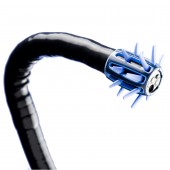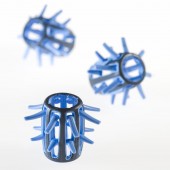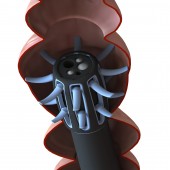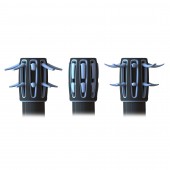
| THE AWARD |
| CATEGORIES |
| REGISTRATION |
| SUBMIT YOUR WORK |
| ENTRY INSTRUCTIONS |
| TERMS & CONDITIONS |
| PUBLICATIONS |
| DATES & FEES |
| METHODOLOGY |
| CONTACT |
| WINNERS |
| PRESS ROOM |
| GET INVOLVED |
| DESIGN PRIZE |
| DESIGN STORE |
| THE AWARD | JURY | CATEGORIES | REGISTRATION | PRESS | WINNERS | PUBLICATIONS | ENTRY INSTRUCTIONS |
Endocuff Colonoscopy Device by Alasdair Barnett |
Home > Winners > Design #28274 >Interview |
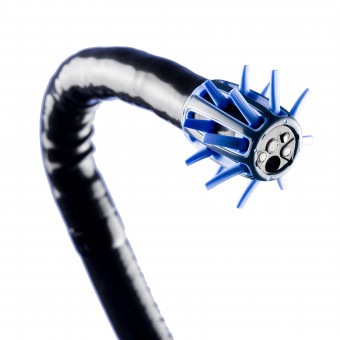 |
|
FS: What is the main principle, idea and inspiration behind your design?
AB: The main source of inspiration came through the practical difficulties in a conventional colonoscopy, including the colonoscope slipping back, the forces required to push can be quite high causing patient discomfort, the tip can move during procedure and is difficult to stabilise and current scopes can miss legions that hide behind colon folds and there is no way to view behind folds. These factors created the design challenge that DesignEdge needed to meet on a technical and aesthetic level, effectively these medical problems were the basis to the inspiration and an eventual solution.
FS: What has been your main focus in designing this work? Especially what did you want to achieve?
AB: The main focus was to design and develop an innovative disposable device that slips onto the end of conventional colonoscopes to improve mucosal vision and enhance tip control. With sixty million procedures worldwide this innovative product will revolutionise detection rates within cancer screening.
FS: What are your future plans for this award winning design?
AB: We are currently exploring various markets and future product derivatives. We will contunue to find simple and effective solutions to everyday problems in medical endoscopy.
FS: How long did it take you to design this particular concept?
AB: Approximately 2 years.
FS: Why did you design this particular concept? Was this design commissioned or did you decide to pursuit an inspiration?
AB: The work was commissioned. After the preliminary testing phase we focused on a design that utilised flexible hairs to grip the side of the colon wall. The collapsible hairs fall flush with the EndoCuff maximising user comfort whilst the device is inserted. The tip hairs fold in to be as small as possible during insertion and while the colonoscope is forced forward. When the scope is extracted the hairs then open out enabling the surgeon to view the colon wall behind the folds whilst the scope is being slowly extracted.
FS: Is your design being produced or used by another company, or do you plan to sell or lease the production rights or do you intent to produce your work yourself?
AB: Arc Medical Design manufacture and market EndoCuff.
FS: What made you design this particular type of work?
AB: DesignEdge specialises in the design of simple and effective medical devices for high volume manufacture. DesignEdge offers a complete design and engineering service to both local and national companies, taking designs through from initial sketches all the way to manufacture.
FS: Where there any other designs and/or designers that helped the influence the design of your work?
AB: Early research explored the natural world including animal skins and fish scales for forward friction traction. Hydroscopic and nano-coatings were explored to improving colonscope movement.
FS: Who is the target customer for his design?
AB: Patients that require a colonoscopy procedure.
FS: What sets this design apart from other similar or resembling concepts?
AB: EndoCuff is a unique and innovative device.
FS: How did you come up with the name for this design? What does it mean?
AB: We need a name to reflective the twin values of medical endoscopy and a device to fit the end of a colonoscope.
FS: Which design tools did you use when you were working on this project?
AB: SolidWorks 3D CAD Software, SolidWorks Simulations
FS: What is the most unique aspect of your design?
AB: EndoCuff features soft flexible projections which gently support the tip of the colonoscope in the centre of the colonic lumen during extubation so providing greater stability and reducing sudden slip back and juddering. This also reduces looping and patient discomfort and pain. The projections evert large folds and flatten small folds so that significantly more mucosa can be visualised with ease. Experienced colonoscopists can use the flexible arms to manipulate folds, polyps and debris to gain a better view without losing vision.
FS: Who did you collaborate with for this design? Did you work with people with technical / specialized skills?
AB: Arc Medical Design, founded in 2007, the company has built a team of key medical opinion leaders as well as experts in medical design, manufacture, finance, regulation and marketing. It takes ideas through the complex processes of development, manufacture and regulatory hurdles to a marketing and distribution network that covers the World. Boddingtons Plastics a specialist in developing technical medical mouldings for volume manufacture.
FS: What is the role of technology in this particular design?
AB: EndoCuff’s unique industrial design uses advanced polymer technology to provide a rigid support structure combined with flexible projections which gently open the colon wall. Each soft projection moves independently, rotating on a hinge at its base providing an improved position for a panoramic view. During forward motion the hairs fall flush with the body of the Endocuff so forward motion is not hindered. The design language reflects a compact, high quality, technically detailed device suitable for the medical environment.
FS: Is your design influenced by data or analytical research in any way? What kind of research did you conduct for making this design?
AB: Materials were fundamental to the success of the project and explored super stretchy silicon materials, friction levels of rubber and hard soft material balance. Supplier research and selection was key to the project success as was meeting medical ethics and regulations. Early practical test were conducted using pig colons using a custom designed test jig to simulate the human colon.
FS: What are some of the challenges you faced during the design/realization of your concept?
AB: The challenge was to create a simple, flexible retrofit cap to improve the colonoscopy procedure in terms of visibility, detection, speed (it is currently a 25-30 minute procedure) and patient comfort. The product also had to be able to attach to a number of colonoscope sizes and be mass produced.
FS: How did you decide to submit your design to an international design competition?
AB: We are keen to promote the EndoCuff device and bring it to the attention of design leaders.
FS: What did you learn or how did you improve yourself during the designing of this work?
AB: The technical challenges and regulatory requirements of the design and development of new products for medical endoscopy.
FS: Thank you for providing us with this opportunity to interview you.
A' Design Award and Competitions grants rights to press members and bloggers to use parts of this interview. This interview is provided as it is; DesignPRWire and A' Design Award and Competitions cannot be held responsible for the answers given by participating designers.
| SOCIAL |
| + Add to Likes / Favorites | Send to My Email | Comment | View Press-Release |

